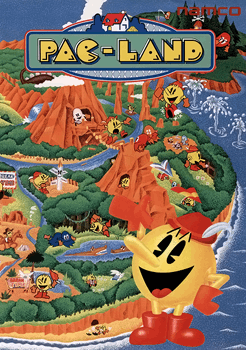Pac-Land
| Pac-Land | |
|---|---|
|
Japanese arcade flyer of Pac-Land (1984) | |
| Developer(s) |
Namco (original) Grandslam Entertainment Mr. Micro |
| Publisher(s) |
|
| Designer(s) | Tsukasa Negoro |
| Programmer(s) | Yoshihiro Kishimoto |
| Artist(s) | Hiroshi Ono |
| Composer(s) | Yuriko Keino |
| Series | Pac-Man |
| Platform(s) | |
| Release date(s) |
August 1984
|
| Genre(s) | Platform game |
| Mode(s) | Up to 2 players, alternating turns |
| Cabinet | Upright, cabaret, and cocktail |
| Arcade system | Namco Pac-Land |
| CPU |
1x Motorola M6809 @ 1.536 MHz, 1x Hitachi HD63701 @ 1.538461 MHz |
| Sound | 1x Namco WSG @ 1.536 MHz |
| Display | Horizontal orientation, Raster, 288 x 224 resolution |
Pac-Land (パックランド Pakku-Rando) is an entry in the Pac-Man series of arcade video games, released into arcades by Namco, and its American distributor Bally Midway (later Midway Games), in August 1984. It was the first Namco arcade game to use the then-new arcade system later titled as Namco Pac-Land. Pac-Land features parallax scrolling for some of the background elements, a feature that would not become commonplace until the 16-bit console era began much later.
Variants
In the Japanese release by Namco, the Pac-Man sprite resembles the official artwork of the character with a longer nose, Pac-Man-shaped eyes, and (for this game) a Tyrolean hat. In the American release of Pac-Land by Bally Midway, the characters' appearances are based on the designs from the Pac-Man animated series produced by Hanna-Barbera to promote the animated series, as well as the video game series. In addition, both versions feature the main background music and "jingles" from the aforementioned series. Midway's version also features faster game play than Namco's.
Gameplay
Pac-Land itself is split into trips. In each of these trips the objective is to get the fairy (that is kept under Pac-man's hat) to Fairyland and also to return home to Pac-Man's house. The majority of the trip involves moving from left to right avoiding various obstacles such as the enemy ghosts, water spurts and quicksand traps. Each trip is divided into a number of rounds, the end of which provides Pac-Man with bonus points depending on how much time he has left and also his position in jumping at the end of each round. If the player runs out of time before finishing the round, Sue, the purple ghost, will speed up rapidly.
The penultimate round of a trip ends with Pac-Man entering Fairyland and returning the fairy under his hat to the Fairy Queen. In return the Fairy Queen gives Pac-Man magic boots. For the final round of the trip, Pac-Man has to travel from right to left back home. For assistance he uses the magic boots, which allow him to jump repeatedly while in mid-air. Once Pac-Man completes the trip, he is greeted by Ms. Pac-Man and Baby Pac-Man. In the US release of the game, Pac-Man's cat and dog in the cartoon series, Sour Puss and Chomp-Chomp, are also there to welcome Pac-Man home. Pac-Man then begins his next trip following the same objectives as before, although the difficulty increases.
As in the original Pac-Man, there are fruit which appear to eat for bonus points and power pellets to turn the ghosts blue and vulnerable. A hidden item (sometimes accidentally dropped by the ghosts) is a Flagship from Galaxian, which rewards 7650 points when collected (a reference to Namco's goroawase number of 765). The Galaxian Flagship is a long running cameo that appears in the Namco-made Pac-Man games. There are also hidden bonuses in the game, eating ghosts in a certain order will give extra time and pushing a fire hydrant in the opposite direction can give extra lives, invincibility, and balloons to collect for points and warps.
Controls
The arcade cabinet version of the game was unique in that, instead of a joystick, it had six plastic buttons, three for each player, although two players would alternate turns in a two-player game. Two buttons moved Pac-Man right and left while third made him jump. Pictographs on the cabinet showed images of Pac-Man moving right and left and jumping. The Turbografx 16 version of the game made an attempt to emulate this by offering a "Type-B" control scheme which switched Pac-Man's movements to the buttons on the controller rather than the thumb-pad. Also the Famicom version uses A and B to run and the D-pad to jump. This is contrast with the majority of Famicom games which uses the D-pad to run, A to jump and B to attack.
Ports and related releases
Pac-Land was released to several home consoles and computers, including the Commodore 64, the Commodore Amiga, the Atari Lynx, the Atari ST, the TurboGrafx-16, the ZX Spectrum, the Amstrad CPC, the MSX, and the NES with the latter also available for the Wii U Virtual Console.
Pac-Land remained a fixture in many video arcades through the mid-1990s, and was republished in 1996 as part of Namco Museum Volume 4 for the PlayStation. A board game and a handheld LCD game of Pac-Land were also produced. In 2012, Namco released Pac-Land on the Namco Arcade app for the iPhone and iPad. Pac-Land is also one of the games included in Pac-Man Museum. All of the ports to home consoles and computers released inside and outside Japan are based on Namco's version of the game, but the Namco Arcade application version of the game is based on the Midway version in non-Japanese versions of the application and the Namco version in the Japanese version.
The game also appeared as a stage in Super Smash Bros. for Wii U.
External links
Pac-Land at the Killer List of Videogames
- Pac-Land at the Arcade History database
- Pac-Land at MobyGames
- Pac-Land at World of Spectrum
